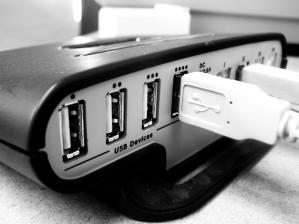| USB
Universal Serial Bus | |

Original USB Logo | |
| Year created: | January 1996 |
| | |
In information technology, Universal Serial Bus (USB) is a serial bus standard to interface devices to a host computer. USB was designed to allow many peripherals to be connected using a single standardized interface socket and to improve the plug-and-play capabilities by allowing hot swapping, that is, by allowing devices to be connected and disconnected without rebooting the computer or turning off the device. Other convenient features include providing power to low-consumption devices without the need for an external power supply and allowing many devices to be used without requiring manufacturer specific, individual device drivers to be installed.
USB is intended to replace many legacy varieties of serial and parallel ports. USB can connect computer peripherals such as mouse, keyboards, PDAs, gamepads and joysticks, scanners, digital cameras, printers, personal media players, and flash drives. For many of those devices USB has become the standard connection method. USB was originally designed for personal computers, but it has become commonplace on other devices such as PDAs and video game consoles, and as a bridging power cord between a device and an AC adapter plugged into a wall plug for charging purposes. As of 2008, there are about 2 billion USB devices in the world.[1]

USB signaling
USB supports three data rates:
- The Full Speed rate of 12 Mbit/s (1.5 MB/s) is the basic USB data rate defined by USB 1.0. All USB hubs support Full Speed.
- A Low Speed rate of 1.5 Mbit/s (187.5 kB/s) is also defined by USB 1.0. It is very similar to full speed operation except that each bit takes 8 times as long to transmit. It is intended primarily to save cost in low-bandwidth Human Interface Devices (HID) such as keyboards, mice, and joysticks.
- A High-Speed (USB 2.0) rate of 480 Mbit/s (60 MB/s) was introduced in USB 2.0. All high-speed devices are capable of falling back to full-speed operation if necessary.
Experimental data rate:
- A Super-Speed (USB 3.0) rate of 4.8 Gbit/s (600 MB/s). The USB 3.0 specification was released by Intel and its partners in August 2008, according to early reports from CNET news. According to Intel, bus speeds will be 10 times faster than USB 2.0 due to the inclusion of a fibre-optic link that works with traditional copper connectors. Products using the 3.0 specification are likely to arrive in 2009 or 2010.
Types of USB connector


• 8-pin mystery plug
• Mini-B plug
• B-type plug
• A-type receptacle
• A-type plug


USB cables
| Pin | Name | Cable color | Description |
|---|---|---|---|
| 1 | VCC | Red | +5V |
| 2 | D− | White | Data − |
| 3 | D+ | Green | Data + |
| 4 | GND | Black | Ground |
The maximum length of a standard USB cable is 5.0 meters (16.4 ft). The primary reason for this limit is the maximum allowed round-trip delay of about 1500 ns.
| Pin | Name | Color | Description |
|---|---|---|---|
| 1 | VCC | Red | +5 V |
| 2 | D− | White | Data − |
| 3 | D+ | Green | Data + |
| 4 | ID | none | permits distinction of Micro-A- and Micro-B-Plug Type A: connected to Ground Type B: not connected |
| 5 | GND | Black | Signal Ground |
The data cables are a twisted pair to reduce noise and crosstalk.
Mystery micro plug
(continuing the above section, on the small 8-pin plug which is apparently misidentified as "micro-B" in this image)
Wireless USB is a short-range, high-bandwidth wireless radio communication protocol created by the Wireless USB Promoter Group. Wireless USB is sometimes abbreviated as "WUSB", although the USB Implementers Forum discourages this practice and instead prefers to call the technology "Certified Wireless USB" to differentiate it from competitors. Wireless USB is based on the WiMedia Alliance's Ultra-WideBand (UWB) common radio platform, which is capable of sending 480 Mbit/s at distances up to 3 meters and 110 Mbit/s at up to 10 meters. It was designed to operate in the 3.1 to 10.6 GHz frequency range, although local regulatory policies may restrict the legal operating range for any given country.
An upcoming 1.1 specification will increase speed to 1 Gbit/s and working frequencies up to 6 GHz.
“Wireless USB” is also the name of a separate wireless protocol created by Cypress Semiconductor for human interface devices.
 Optical USB Mini Mouse Electronics
Optical USB Mini Mouse Electronics


|
Lis |
DESCRIPTION:
The only iPod charger you will ever need - high quality, multi-optional and convenient!
Our multi charger offers the perfect charging for any iPod
With our multi charger, you will get a mains, Car and USB charger in one great pack. Whatever iPod you have, simply attach the compatible adaptor to your power source of choice!
COMPATIBLE WITH:
iPod shuffle, iPod 3G, iPod 4G, iPod Color, iPod Photo, iPod Video, iPod Mini & iPod Nano
CONTENTS:
Mains, USB travel charger, CAR charger





No comments:
Post a Comment